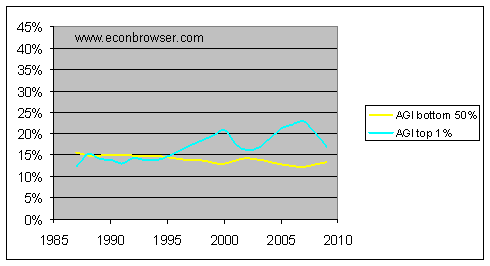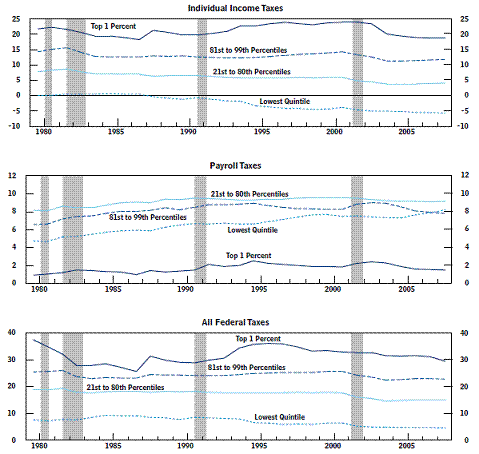Trying to prevent an increase in tax rates on the richest 1% of Americans looks to me like a losing strategy for the Republicans.
Let me begin with what should be an indisputable fact: income inequality in the United States has been significantly increasing over the last generation. The new report from the Congressional Budget Office recently highlighted by Menzie has a lot of evidence in support of that statement.
Here is some more evidence of the trend. In 1987, 106 million Americans filed tax returns reporting a positive value for adjusted gross income (AGI). The total income for the 53 million households in the bottom half of the distribution sums to $440 billion, which was 15.6% of the total of $2.8 trillion for all 106 million returns– half the filers had less than 16% of the income. That percentage is plotted as the yellow line in the graph below. It has been trending down over the last 15 years, with the bottom 50% only having 12.8% of the income in 2009.

Yellow: percent of adjusted gross income accounted for by tax returns with positive AGI but in the bottom 50%, 1987-2009. Turquoise: percent of AGI accounted for by top 1%. Data source: Tax Foundation.
The turquoise line in the graph above is the share of AGI accounted for by the top 1%. During 1987-1995, the top 1% had almost as much total income as the combined income of the bottom 50%. Since 1995, the share of the top 1% has climbed to where the top 1% now earn significantly more than the bottom 50% combined. Despite the noticeable dips in the recessions of 2001 and 2007-2009, in 2009 the top 1% accounted for almost 17% of all the income reported.
Throughout this period, the U.S. has had a progressive income tax structure– the rich pay a higher percentage of their income than the middle class. And because the incomes of the rich have gone up faster than the middle class, their share of income taxes collected has risen significantly. In 1987, of the $369 billion collected in income taxes, only $22 billion, or 6%, came from the bottom half of those tax returns that had reported a positive AGI. By 2009, the share of income taxes paid by the bottom 50% had fallen to 2.25%, as indicated by the yellow line on the graph below.

Yellow: percent of federal income tax receipts accounted for by tax returns with positive AGI but in the bottom 50%, 1987-2009. Turquoise: percent of federal income tax receipts accounted for by top 1%. Data source: Tax Foundation.
For comparison, the top 1% in 1987 accounted for about 25% of all federal income tax dollars collected in 1987, and for almost 37% in 2009, as indicated by the turquoise line in the above graph.
The top panel in the graph below shows how the average federal income tax rate for different percentiles has changed over time. The richer households have always paid a higher income tax rate. The income tax rate for the lowest quintile has declined since 1990, while that for the top 1% first rose and then was cut, being today back about where it was in 1990.

Federal taxes as a percentage of household income, by income group. Source: Congressional Budget Office.
However, the income tax is not the only source of revenue for the federal government. Social Security and Medicare contributions are also significant. Because the former only apply to the first $106,800 in income, the percentage of income paid in Social Security contributions actually falls as your income rises. As currently implemented, U.S. federal income taxes are progressive, whereas our payroll taxes are regressive. The middle panel above shows the average payroll tax rates for different percentiles. The middle class (21st to 80th percentile) has consistently paid a higher average payroll tax rate than the rich, and the gap has increased as the incomes of the latter grew faster than those in the middle.
The combined effect of income and payroll taxes still remains modestly progressive, as seen in the bottom panel above. The net effect of current federal taxes is to slightly reduce the inequality in after-tax income, as seen in the Lorenz Curve below.

Source: Congressional Budget Office.
The period in which the top 1% have realized a growing share of after-tax income has not been very favorable economically for the American working class. I have a hard time pointing to ways in which typical Americans could be claimed to have benefited by the growing inequality.
Furthermore, given the size of America’s fiscal challenges, it is simply inconceivable to me that the country would ever agree to spending cuts of the magnitude that by themselves could return us to a sustainable fiscal path. Whether you think it’s a good idea to increase taxes on the wealthy or not, a pragmatist would acknowledge that it is inevitable.
I am therefore puzzled that the Republicans have chosen to draw a line in the sand on the question of raising taxes on the top 1%. The Republican position looks like a loser politically, is intellectually and morally difficult to defend, and puts them in a battle whose outcome is already known.
So why fight it?
- Bulenox: Get 45% to 91% OFF ... Use Discount Code: UNO
- Risk Our Money Not Yours | Get 50% to 90% OFF ... Use Discount Code: MMBVBKSM
Disclaimer: This page contains affiliate links. If you choose to make a purchase after clicking a link, we may receive a commission at no additional cost to you. Thank you for your support!



Leave a Reply